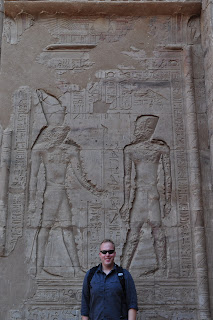By our third day in Egypt we were really starting to get the hang of things. Our mornings usually consisted of getting up early to get a start visiting temples. The afternoons were spent on board enjoying the scenery and cruising the Nile. The nights were spent enjoying dinner and conversation with our new friends. What a wonderful vacation!
The night before we had arrived in Edfu where we visited the Temple of Horus, the falcon god, in the morning. We were told that we would take a horse drawn carriage to the temple, which unfortunately we couldn't opt out of. It's an experience that I look forward to never doing again. The horses are so small and thin, and really are not treated all that well. This temple is much younger than the others we had seen, it was began by Ptolemy II in 237 BC. Way less cool, right? It's only 2,200 years old. (If only I could convey sarcasm through writing.) This was another temple that 200 years ago had been swallowed up by the desert, but was unearthed in the 1800's. One thing that was slightly annoying about this trip was the fact that all the small cruise ships had the same schedule, which meant that we would arrive at the same place at the same time. Which equaled large crowds, in small spaces, all at once, definitely not one of my favorite things.
 |
| Colleen and I, perhaps laughing at our ridiculous carriage ride. |
 |
| The driver let Patrick take the reigns for longer than I was comfortable with. |
Here's a few of the things that I enjoyed most about this visit. First was at the very back of the temple was an ancient blue print. The temple plan was carved into the wall with the details indicated by symbols. I'm still not really sure what each symbol meant, but it was still pretty cool. Another thing was the Nilometer, this was a line carved into the wall at the base of the temple used as a form of measurment for taxes. When the Nile flooded the government would take note of the water height on the Nilometer. If it was above the carved line that would mean the flood was great, therefore leading to a good year for agriculture and more money for the people, equaling more taxes for the government. If the water height was below the Nilometer than the government would be more lenient on taxes, and quite possibly begin preparing for famine.
 |
| The ancient blue print. |
The last was a tourist dressed in an Egyptian galabia. On each of the cruise ships there is one night called the 'galabia' party. You're supposed to purchase a galabia, which is a traditional Egyptian piece of clothing. They essentially look like long shirt dresses. Most men outside of Cairo still wear a version of them today, though they are much more simple, with no embellishment. The ones that are sold to tourists are a bit ridiculous, they are adorned with beads, buttons, embroidery. They sell them on the ship, of course, and 'you really should buy one because you won't just wear it here'. 'Oh really? I won't? Where else where I might want to wear one?' 'Around the house, out in the garden.' We weren't sold on the idea. We were, the four of us, boring Americans wearing our everyday wear to the galabia party. However, we did get a kick out of this guy wearing his to the temple. Though I have to admit that I admire his dedication.

We returned to the ship and went a bit further down river where we visited Kom Ombo, the temple devoted to both Sobek, god of the crocodiles, and Haroeris, god of the falcons (but not the same god as above). The temple is right off the bank of the Nile, just as you'd expect a temple to the crocodile god to be. This is also the only temple that is dedicated to two gods. At the back of the temple are carvings (well all around the temple, but these in particular are fascinating) depicting what some believe are ancient medical tools. Some of these instruments include scalpels, pouches of medicine, scales for weighing medicine, hooks, a bar with two hooks supposedly meant for women to use during childbirth. There is some debate as to whether these depictions are indeed medical instruments, but how intriguing!
 |
| Ancient medical instruments? You decide. |











Comments
Post a Comment